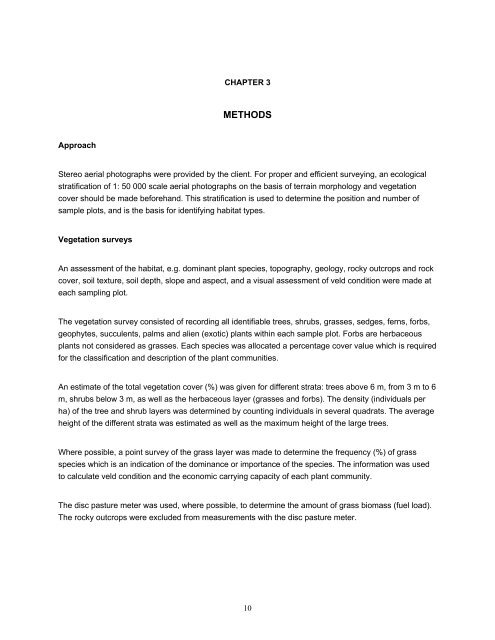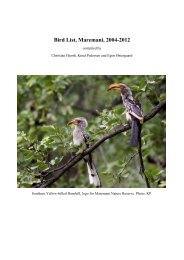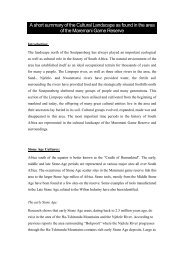the vegetation types and veld condition - Maremani Nature Reserve
the vegetation types and veld condition - Maremani Nature Reserve
the vegetation types and veld condition - Maremani Nature Reserve
You also want an ePaper? Increase the reach of your titles
YUMPU automatically turns print PDFs into web optimized ePapers that Google loves.
Approach<br />
CHAPTER 3<br />
METHODS<br />
Stereo aerial photographs were provided by <strong>the</strong> client. For proper <strong>and</strong> efficient surveying, an ecological<br />
stratification of 1: 50 000 scale aerial photographs on <strong>the</strong> basis of terrain morphology <strong>and</strong> <strong>vegetation</strong><br />
cover should be made beforeh<strong>and</strong>. This stratification is used to determine <strong>the</strong> position <strong>and</strong> number of<br />
sample plots, <strong>and</strong> is <strong>the</strong> basis for identifying habitat <strong>types</strong>.<br />
Vegetation surveys<br />
An assessment of <strong>the</strong> habitat, e.g. dominant plant species, topography, geology, rocky outcrops <strong>and</strong> rock<br />
cover, soil texture, soil depth, slope <strong>and</strong> aspect, <strong>and</strong> a visual assessment of <strong>veld</strong> <strong>condition</strong> were made at<br />
each sampling plot.<br />
The <strong>vegetation</strong> survey consisted of recording all identifiable trees, shrubs, grasses, sedges, ferns, forbs,<br />
geophytes, succulents, palms <strong>and</strong> alien (exotic) plants within each sample plot. Forbs are herbaceous<br />
plants not considered as grasses. Each species was allocated a percentage cover value which is required<br />
for <strong>the</strong> classification <strong>and</strong> description of <strong>the</strong> plant communities.<br />
An estimate of <strong>the</strong> total <strong>vegetation</strong> cover (%) was given for different strata: trees above 6 m, from 3 m to 6<br />
m, shrubs below 3 m, as well as <strong>the</strong> herbaceous layer (grasses <strong>and</strong> forbs). The density (individuals per<br />
ha) of <strong>the</strong> tree <strong>and</strong> shrub layers was determined by counting individuals in several quadrats. The average<br />
height of <strong>the</strong> different strata was estimated as well as <strong>the</strong> maximum height of <strong>the</strong> large trees.<br />
Where possible, a point survey of <strong>the</strong> grass layer was made to determine <strong>the</strong> frequency (%) of grass<br />
species which is an indication of <strong>the</strong> dominance or importance of <strong>the</strong> species. The information was used<br />
to calculate <strong>veld</strong> <strong>condition</strong> <strong>and</strong> <strong>the</strong> economic carrying capacity of each plant community.<br />
The disc pasture meter was used, where possible, to determine <strong>the</strong> amount of grass biomass (fuel load).<br />
The rocky outcrops were excluded from measurements with <strong>the</strong> disc pasture meter.<br />
10




